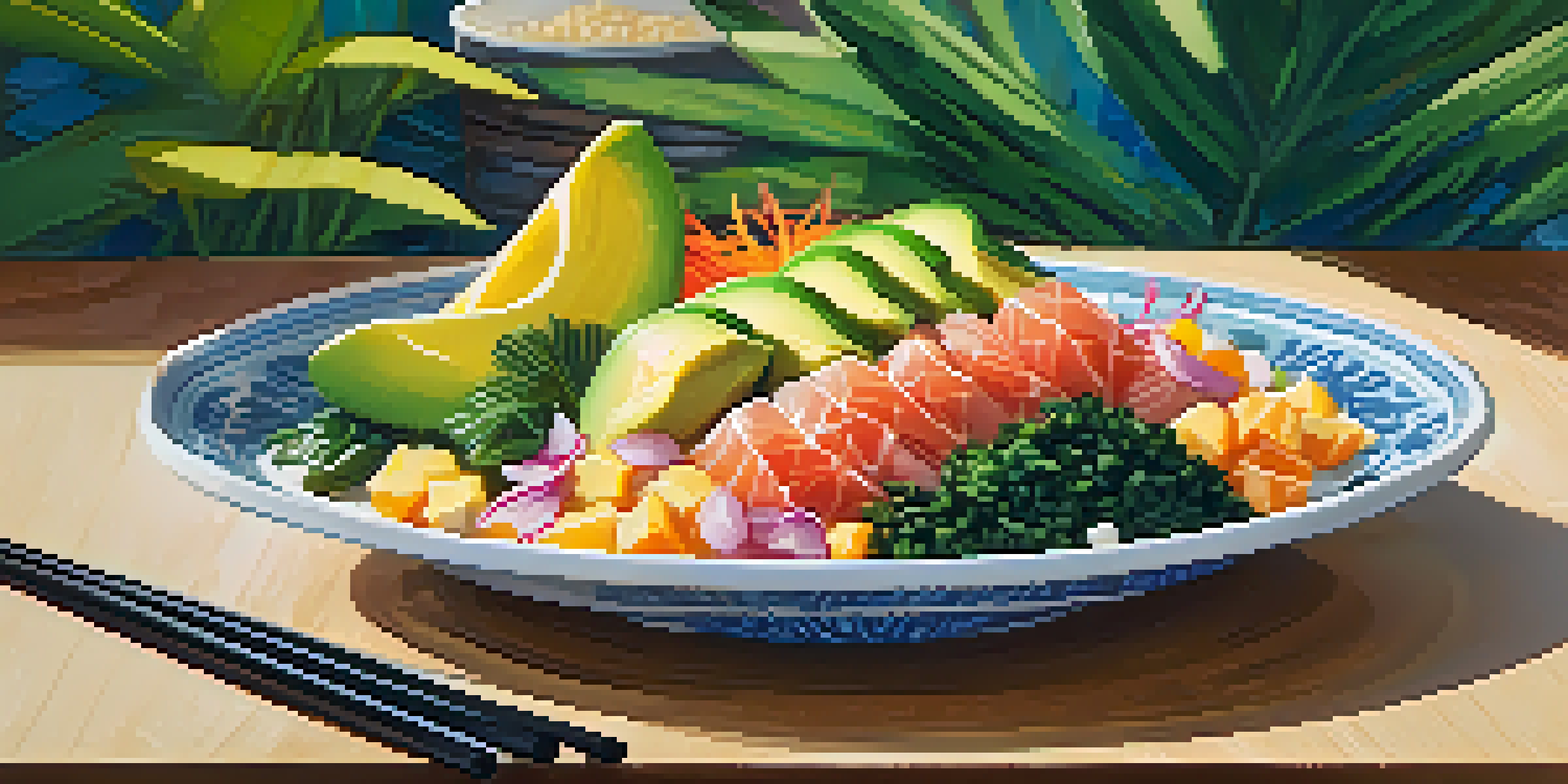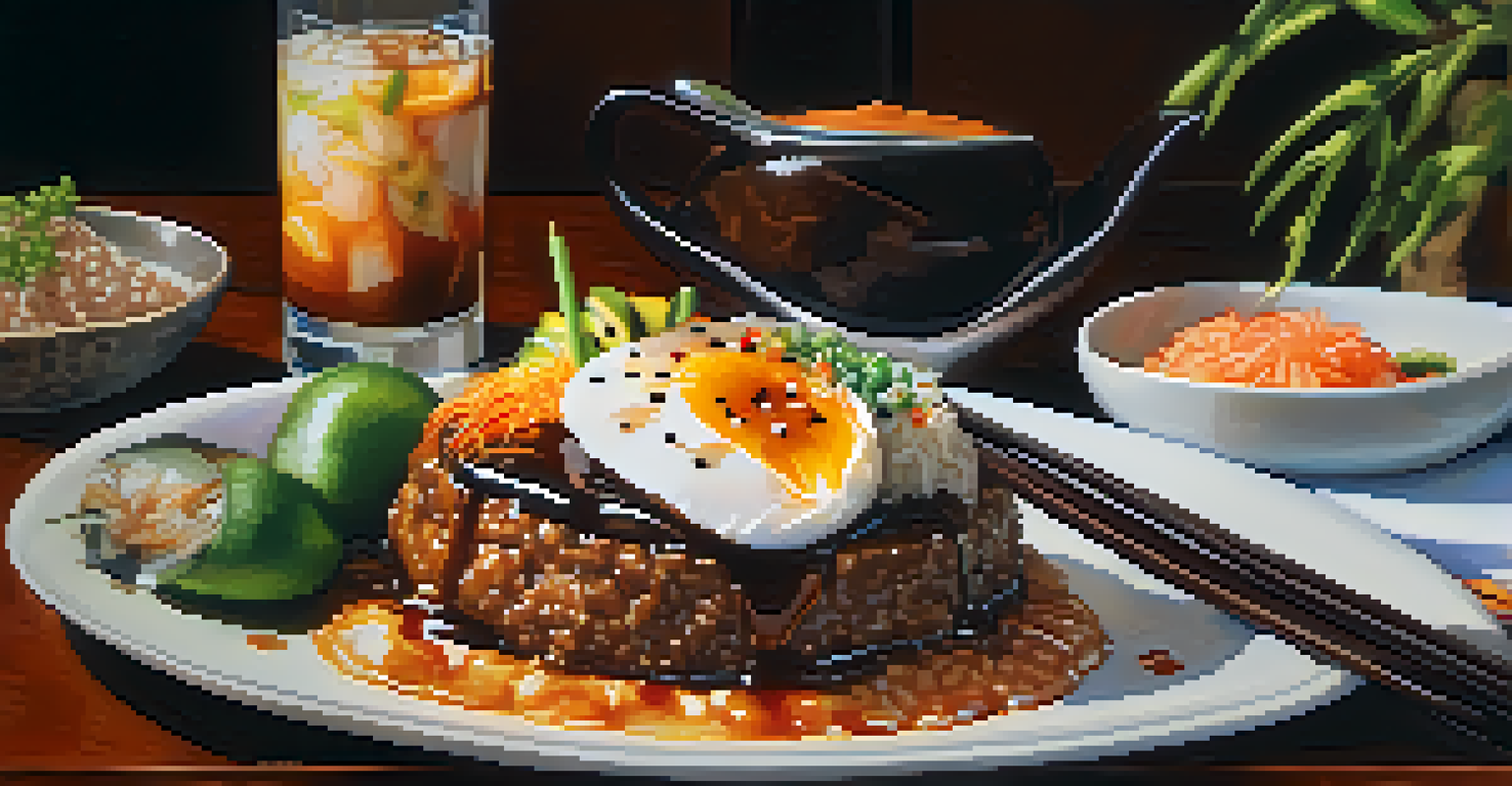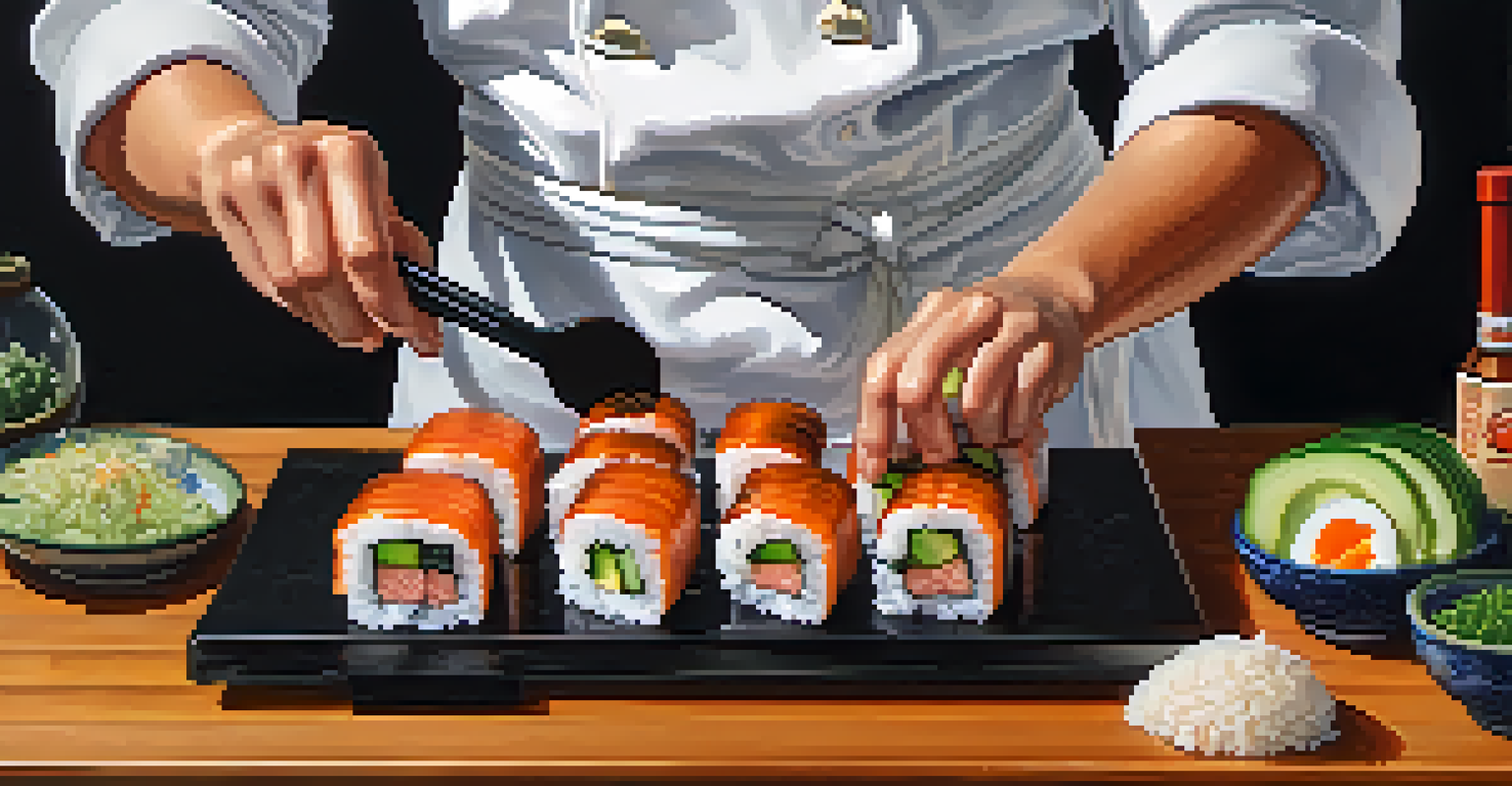Exploring the Hawaiian-Asian Fusion Cuisine in Honolulu

The Roots of Hawaiian-Asian Fusion Cuisine
Hawaiian-Asian fusion cuisine is a delightful blend that stems from the rich cultural heritage of Hawaii. The islands have always been a melting pot of various cultures, thanks to their history of immigration from Asia, particularly from countries like Japan, China, and the Philippines. This culinary fusion offers a unique twist on traditional Hawaiian dishes, making each meal an exciting exploration of flavors.
Food is our common ground, a universal experience.
Imagine a plate that combines the savory taste of poke with the bright notes of a soy-based marinade—this is just a glimpse of what fusion cuisine has to offer. The blending of ingredients and cooking techniques creates a beautiful harmony that reflects the diverse influences on Hawaiian cooking. It's a celebration of both local and Asian ingredients that results in mouthwatering dishes.
As you wander through Honolulu, you'll find that this fusion cuisine is not just about the food but also about the stories and histories behind each dish. It’s a culinary journey that invites you to taste the islands' past and present, making every meal a memorable experience.
Must-Try Dishes: A Culinary Adventure
When it comes to Hawaiian-Asian fusion cuisine, there are some must-try dishes that you simply can't miss. For instance, the ‘Loco Moco’—traditionally a Hawaiian dish—often features a twist with teriyaki sauce or kimchi, showcasing the blend of flavors. Each bite brings together the comforting elements of rice, gravy, and protein with a spicy or sweet kick.

Another standout is the ‘Poke Bowl,’ where fresh fish is mixed with Asian-inspired marinades like ponzu or sesame oil. Topped with crispy seaweed and avocado, these bowls are not only delicious but also visually stunning. It’s a perfect example of how the fusion of Hawaiian and Asian ingredients can elevate a simple dish into something extraordinary.
Fusion Cuisine Reflects Cultural Diversity
Hawaiian-Asian fusion cuisine embodies the rich tapestry of Hawaii's cultural heritage, celebrating the blend of flavors and traditions from various immigrant influences.
Don’t forget to try ‘Spam Musubi’—a beloved snack in Hawaii that has been embraced by Asian influences. This delightful treat combines sushi rice and teriyaki-glazed Spam, wrapped in seaweed. It's a testament to how flavors from different cultures can come together to create something uniquely Hawaiian.
Local Ingredients: The Heart of Fusion Cuisine
At the core of Hawaiian-Asian fusion cuisine is the use of fresh, local ingredients that reflect the islands’ bounty. From tropical fruits like pineapple and mango to fresh seafood, the emphasis is on quality and flavor. The availability of these ingredients allows chefs to create dishes that are not only fresh but also resonate with the local culture.
Cooking is like love. It should be entered into with abandon or not at all.
For instance, the use of taro, a staple in Hawaiian cooking, can be seen in various fusion dishes. Taro can be transformed into chips or incorporated into desserts, showcasing its versatility. This ingredient links the traditional Hawaiian fare with innovative Asian techniques, resulting in a unique culinary experience.
Moreover, the integration of Asian vegetables, such as bok choy and daikon, adds a fresh crunch and vibrant color to many dishes. This commitment to local sourcing ensures that every meal is a celebration of the islands' natural resources while paying homage to Asian culinary traditions.
Honolulu's Best Restaurants for Fusion Cuisine
If you're eager to indulge in Hawaiian-Asian fusion cuisine, Honolulu is home to some of the best restaurants that showcase this unique blend. Places like ‘The Pig and the Lady’ offer a menu that marries Vietnamese flavors with local ingredients, resulting in dishes that burst with freshness. Here, the pho may be infused with elements that celebrate Hawaiian culture, creating a delightful dining experience.
Another gem is ‘Nico’s Pier 38,’ where you can enjoy fresh poke and other seafood dishes that often incorporate Asian sauces and spices. The laid-back atmosphere combined with the incredible flavors makes it a local favorite. Dining here gives you a taste of how the ocean's bounty can be seamlessly blended with Asian culinary techniques.
Must-Try Dishes for Culinary Adventurers
Dishes like Loco Moco, Poke Bowls, and Spam Musubi showcase the innovative combination of Hawaiian and Asian ingredients, making each meal a delightful experience.
For a more upscale experience, check out ‘MW Restaurant,’ where the chefs expertly craft dishes that reflect both Hawaiian and Asian influences. The seasonal menu highlights the best of what’s available locally, ensuring a unique dining experience every time you visit. It's a perfect spot for food lovers looking to explore the depths of Hawaiian-Asian fusion.
Cultural Significance of Fusion Cuisine
Beyond just tantalizing the taste buds, Hawaiian-Asian fusion cuisine holds deep cultural significance. It reflects the history of Hawaii as a crossroads of various cultures, where different traditions coalesce to create something new and beautiful. This culinary fusion serves as a reminder of the islands' diverse heritage and the stories that come with it.
Food has always been a way to bring people together, and fusion cuisine embodies this spirit. When families and friends gather around a table filled with these unique dishes, they are not only sharing a meal but also celebrating the blend of cultures that define Hawaii. Each dish carries with it a narrative of migration, adaptation, and community.
In many ways, enjoying Hawaiian-Asian fusion cuisine is an act of cultural appreciation. It invites diners to engage with the rich tapestry of flavors and histories that make up the culinary landscape of Hawaii. As you savor each bite, you become part of a larger story that connects the past with the present.
Cooking Techniques: A Blend of Traditions
The cooking techniques used in Hawaiian-Asian fusion cuisine are as diverse as the flavors themselves. Traditional Hawaiian cooking often involves methods like imu (underground oven) and grilling, while Asian influences bring in techniques like stir-frying and steaming. This combination allows for a variety of textures and flavors in each dish.
For example, grilling is a common method used for marinated meats, infusing them with smoky flavors. When combined with Asian marinades, the result is a deliciously tender and flavor-packed dish that represents the best of both worlds. The versatility of these techniques provides chefs with endless possibilities for creative expression.
Future Trends in Fusion Cuisine
As chefs embrace sustainability and innovation, Hawaiian-Asian fusion cuisine is poised to evolve, engaging food enthusiasts and preserving its unique culinary narratives.
Additionally, the use of fresh herbs and spices is vital in both Hawaiian and Asian cuisines. Ingredients like ginger, garlic, and fresh cilantro are commonly utilized to enhance flavors. This careful attention to the cooking process ensures that every dish is not only delicious but also respects the traditions from which it originates.
The Future of Hawaiian-Asian Fusion Cuisine
As culinary trends continue to evolve, the future of Hawaiian-Asian fusion cuisine looks bright and promising. Chefs are increasingly experimenting with new flavors and techniques, pushing the boundaries of traditional dishes. This innovation keeps the cuisine fresh and exciting for both locals and visitors alike.
Sustainability is also becoming a significant focus in the culinary world, and Hawaiian-Asian fusion cuisine is no exception. Many restaurants are adopting practices that support local farmers and promote eco-friendly sourcing. This not only enhances the quality of the dishes but also contributes positively to the community and environment.

Finally, the growing interest in food culture means that more people are eager to learn about and experience Hawaiian-Asian fusion cuisine. Food festivals, cooking classes, and pop-up events are becoming popular, allowing enthusiasts to dive deeper into this unique culinary tradition. This engagement ensures that the flavors and stories behind the cuisine will continue to thrive for generations to come.